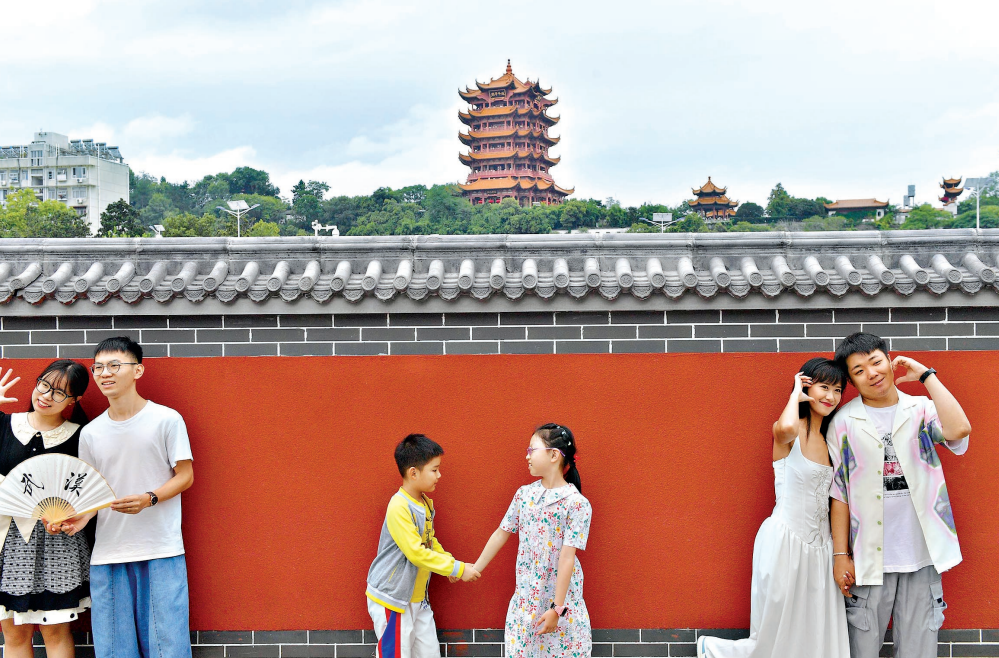“Yellow Crane Tower’s red wall, Bagong House… Wuhan has more and more popular photo spots.” Several citizens commented on the Yangtze River Daily’s urban message board, suggesting that during the “15th Five-Year Plan” period, more tourists will visit Wuhan’s popular photo spots, and it is recommended to give these spots a “minor makeover” to make Wuhan more photogenic, allowing tourists to take the most beautiful photos of Wuhan home.
Tourists take photos in front of the Yellow Crane Tower’s red wall.
“Wuhan’s ‘minor makeover’ of the photo spots near the Yellow Crane Tower has been very successful.” A photographer said, “The red wall outside the Simenkou Yellow Crane Tower Station on Metro Line 5 has become a popular photo spot for tourists. Many of my friends from other cities, after seeing photos of the Yellow Crane Tower’s red wall, visit the spot when they come to Wuhan.”
“Can we learn from the experience of the Yellow Crane Tower’s red wall and give some of Wuhan’s well-known photo spots a ‘minor makeover’ to make them more photogenic?” A citizen said that the traffic lights in front of Bagong House and the lampposts in front of the former residence of Jardine Matheson affect the photo quality, and her friends from other cities have to use editing software to remove them. Is it possible to relocate the lampposts to make these two spots more photogenic?
The citizen said: “Of course, public facilities are necessary, as travel safety is the top priority. I just wonder if there is a better solution that balances aesthetics and safety.”
The photographer also believes that from the perspective of “urban aesthetics,” popular photo spots could be given a “minor makeover” to make “a more photogenic Wuhan” attract more visitors.
Yellow Crane Tower
The Yellow Crane Tower is a famous Chinese tower located in Wuhan, Hubei Province, with a history dating back over 1,700 years to the Three Kingdoms period. Originally built for military observation, it has been destroyed and rebuilt multiple times, with its current structure dating from 1985. It is celebrated in classical Chinese poetry and is a renowned symbol of the city.
Bagong House
The Bagong House is a traditional Korean residence from the Joseon Dynasty, known for its distinctive architectural style featuring a curved “bagong” (hip-and-gable) roof. It represents the elegant and practical design of upper-class homes from that era, showcasing historical Korean craftsmanship and living culture.
Wuhan
Wuhan is a major city in central China, formed in 1927 from the merger of the three historic towns of Wuchang, Hankou, and Hanyang. It is historically significant as the site of the 1911 Wuchang Uprising, which led to the fall of the Qing Dynasty. Today, it is a modern metropolis known as an important economic and transportation hub.
Yangtze River Daily
“Yangtze River Daily” is a major state-run newspaper based in Wuhan, Hubei Province, China. It was first published in 1949 and serves as the official mouthpiece of the Wuhan Municipal Committee of the Chinese Communist Party. The publication primarily covers local news and policies while promoting the party’s directives to the public.
Simenkou Yellow Crane Tower Station
Simenkou Yellow Crane Tower Station is a modern subway station on Wuhan Metro Line 4, named for its proximity to the city’s iconic Yellow Crane Tower. The station serves as a major transport hub, providing direct access for visitors to the historic tower, a renowned cultural monument originally built in the 3rd century and celebrated in classical Chinese poetry.
Metro Line 5
Metro Line 5 is a major subway line in Paris, France, which first opened in 1906. It is one of the city’s oldest lines and is historically significant for connecting several major railway stations, including Gare du Nord and Gare de l’Est.
Jardine Matheson
Jardine Matheson is a major British multinational corporation, originally founded as a trading company in Canton (now Guangzhou), China, in 1832. It played a pivotal and controversial role in the 19th-century opium trade between British India and China, an enterprise that led to the First Opium War. Today, it is a diversified conglomerate with a significant presence across Asia, operating in sectors including property, hospitality, and retail.
urban aesthetics
“Urban aesthetics” is not a specific place but a field of study and practice concerned with the visual and sensory qualities of cities. It examines the design, art, and overall appearance of urban environments, from architecture and public spaces to street art and lighting. Its history is tied to the development of cities themselves, evolving with movements like modernism and postmodernism that have shaped how we design and experience metropolitan areas.




